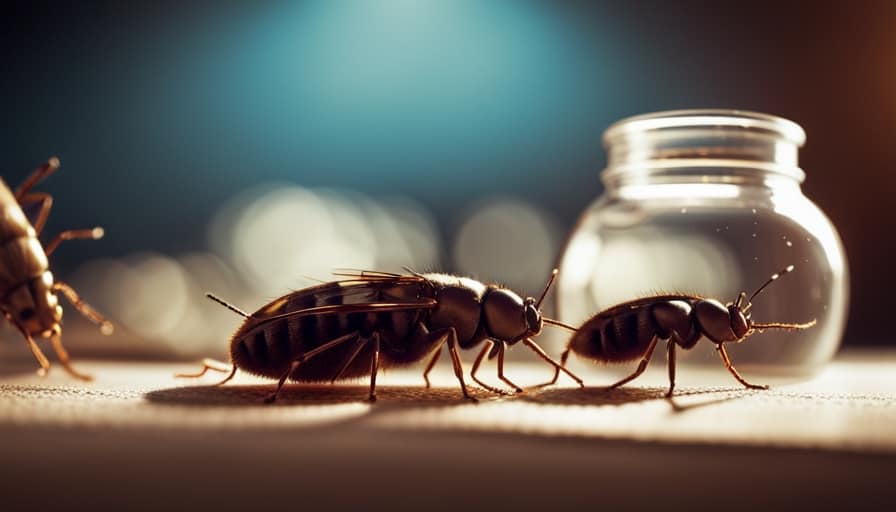As someone who loves plants, I have faced numerous small insects invading my cherished houseplants. It can be frustrating to watch them devouring the leaves, but do not worry!
I’ve discovered effective ways to keep those pesky pests at bay. In this article, I’ll share my knowledge and expertise on identifying common house plant pests, natural remedies to repel them, and proper plant care techniques to prevent infestations.
Say goodbye to those tiny bugs and hello to healthy, thriving house plants!
Key Takeaways
- Regularly inspect your house plants for signs of pests to catch infestations early.
- Use natural remedies like essential oils, DIY traps, garlic and vinegar sprays, and citrus peels to repel tiny bugs.
- Practice proper plant care, such as maintaining a clean environment, avoiding overwatering, and providing adequate sunlight and ventilation, to prevent infestations.
- Consider using insecticidal soaps and sprays as a safe and effective method for controlling pests on house plants.
Identifying Common House Plant Pests
I can easily identify common house plant pests by observing their physical characteristics and the damage they cause.

When it comes to natural pest control in house plants, there are several types of beneficial insects that can help keep these pests at bay. Ladybugs are one such example, as they feed on aphids, mealybugs, and scale insects. Another beneficial insect is the green lacewing, which preys on aphids, whiteflies, and spider mites.
Identifying a house plant pest infestation can be done by looking out for common signs and symptoms. These include yellowing or wilting leaves, distorted growth, sticky residue on the leaves, and tiny holes or bite marks.
Natural Remedies to Repel Tiny Bugs
To naturally repel tiny bugs from your house plants, try using essential oils or vinegar. These natural remedies are safe for both your plants and the environment. Here are some effective methods you can try:
-
Essential oils as bug repellents: Certain essential oils such as neem oil, peppermint oil, and lavender oil can repel bugs and insects. Mix a few drops of the chosen oil with water and spray it onto the leaves of your plants. This will create a barrier that pests will avoid.

-
DIY traps for house plant pests: Create homemade traps using common household items. For example, you can make a sticky trap by applying petroleum jelly or cooking oil to a yellow index card. Place the card near your plants, and the bugs will get stuck on it.
-
Garlic and vinegar spray: Blend garlic cloves with vinegar and water to create a natural bug repellent. Spray this mixture onto the leaves of your plants to deter pests.
-
Citrus peel deterrent: Bugs dislike the scent of citrus fruits. Place citrus peels around your plants or rub them onto the leaves to keep bugs away.
Using these natural remedies, you can effectively repel tiny bugs from your house plants and keep them healthy and thriving.

Preventing Infestations Through Proper Plant Care
Proper plant care is essential for preventing infestations of tiny bugs in your house plants. By implementing effective pest control techniques and being aware of common signs of plant infestations, you can ensure the health and vitality of your indoor greenery. Here are some key tips to follow:
-
Regularly inspect your plants for any signs of pests, such as yellowing leaves, wilting, or sticky residue.
-
Maintain a clean and tidy environment around your plants, removing any fallen leaves or debris that may attract insects.
-
Avoid overwatering your plants, as excessive moisture can create a breeding ground for pests.

-
Provide adequate sunlight and proper ventilation to promote strong plant growth and discourage pest infestations.
Using Insecticidal Soaps and Sprays
One effective way to control pests on house plants is by using insecticidal soaps or sprays. These products can help eliminate common pests such as aphids, spider mites, and whiteflies.
Here are four reasons why using insecticidal soaps and sprays is beneficial:
-
Efficiency: Insecticidal soaps and sprays work by suffocating pests, making them an effective solution for controlling infestations.

-
Safety: Unlike chemical insecticides, insecticidal soaps and sprays are generally safe to use around humans and pets when used as directed.
-
Environmentally friendly: Many insecticidal soaps and sprays are derived from natural ingredients, making them a more eco-friendly choice for pest control.
-
Additional benefits: Some insecticidal soaps, particularly those containing neem oil, also have antifungal and antibacterial properties, helping to prevent plant diseases.
To ensure the effectiveness of insecticidal soaps and sprays, it’s also important to control humidity levels around your house plants. High humidity can promote pest infestations, so maintaining proper ventilation and avoiding over-watering can help prevent future problems.

Effective Ways to Eliminate Tiny Bugs From House Plants
An effective way to eliminate tiny bugs from my house plants is by using natural remedies and organic pest control methods. DIY pest control methods can be a cost-effective and safe solution for getting rid of these pesky insects without harming the plants or the environment.
There are several common signs of plant pest infestations to look out for, such as yellowing leaves, wilting, distorted growth, and the presence of tiny insects on the plant or in the soil.
To address these issues, I can make my own homemade insecticidal spray using ingredients like neem oil, garlic, or vinegar. These natural remedies can help to repel and kill the pests, restoring the health and beauty of my house plants.
Frequently Asked Questions
How Do I Know if the Bugs on My House Plants Are Harmful or Beneficial?
I determine if bugs on my house plants are harmful or beneficial by researching their appearance and behavior. Beneficial bugs, like ladybugs and lacewings, can be a natural pest control method for my plants.

Can I Use Chemical Pesticides to Get Rid of the Bugs on My House Plants?
I wouldn’t recommend using chemical pesticides to rid your house plants of bugs. While they may be effective, there are potential risks involved. I suggest exploring natural methods that are safer for your plants and the environment.
Are There Any Specific Plants That Naturally Repel Tiny Bugs?
There are specific plants that naturally repel tiny bugs, such as lavender, mint, and marigold. These plants emit scents that are unpleasant to insects, keeping them away from your house plants.
What Are Some Common Signs of Infestation That I Should Look Out For?
What are some common signs of plant infestation? Look for wilting leaves, yellowing or browning foliage, and sticky residue. To prevent bugs in house plants, regularly inspect and clean them, use neem oil or insecticidal soap, and quarantine new plants.
How Often Should I Inspect My House Plants for Pests?
I inspect my house plants for pests regularly to prevent infestations. By implementing natural remedies for pest control, such as neem oil or insecticidal soap, I can keep tiny bugs out of my plants effectively.

Conclusion
In conclusion, by identifying common house plant pests and implementing natural remedies, proper plant care, and the use of insecticidal soaps and sprays, you can effectively keep tiny bugs out of your house plants.
For example, a case study showed that regularly inspecting plants for signs of infestation, using neem oil as a natural repellent, and maintaining optimal humidity levels successfully prevented a whitefly infestation in a collection of orchids.
By following these methods, you can ensure the health and vitality of your house plants.
I’m Theodore, and I love tiny houses. In fact, I’m the author of Tiny House 43, a book about tiny houses that are also tree houses. I think they’re magical places where imaginations can run wild and adventures are just waiting to happen.
While tree houses are often associated with childhood, they can be the perfect adult retreat. They offer a cozy space to relax and unwind, surrounded by nature. And since they’re typically built on stilts or raised platforms, they offer stunning views that traditional homes simply can’t match.
If you’re looking for a unique and romantic getaway, a tree house tiny house might just be the perfect option.










